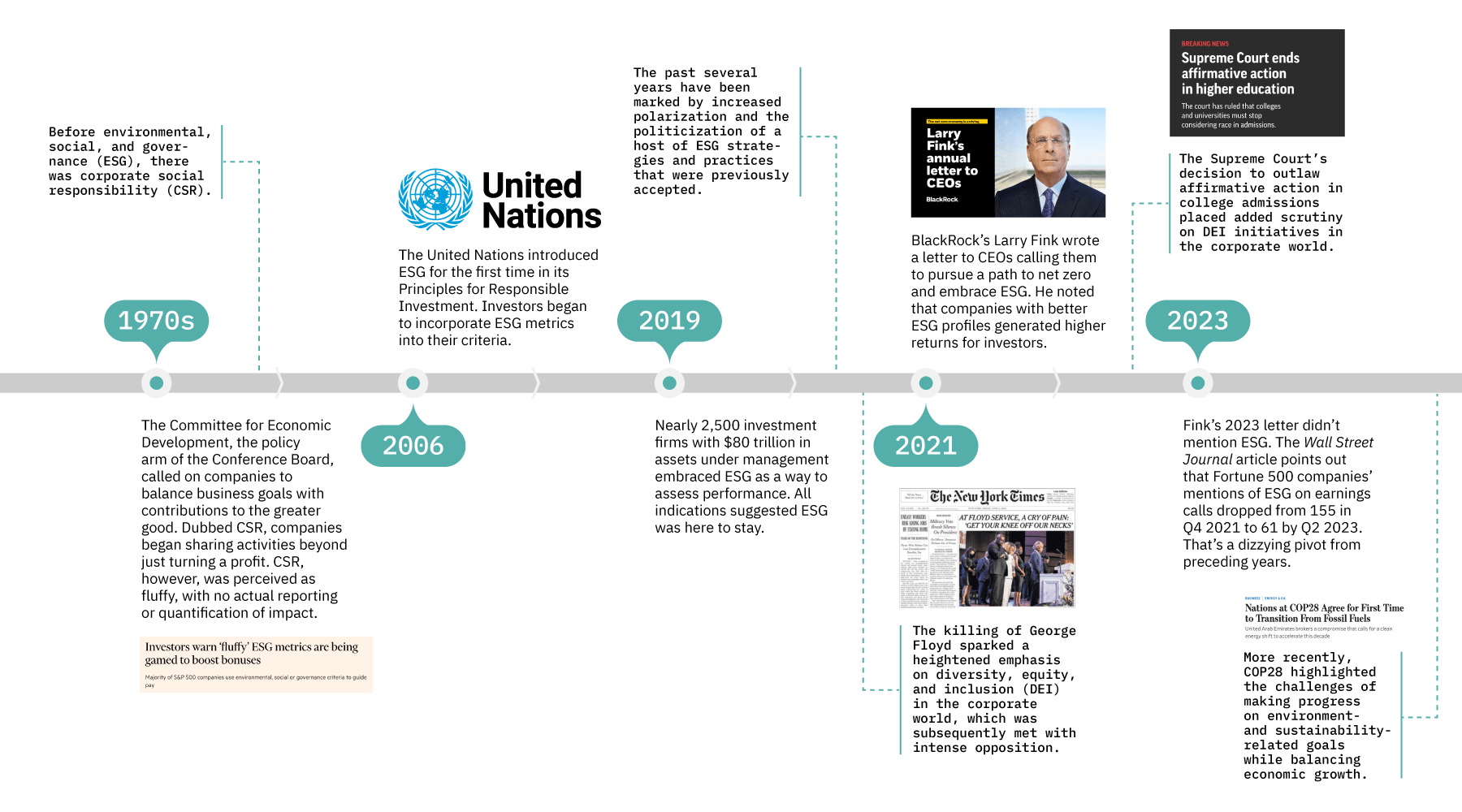Recently, the Wall Street Journal reported that the term ESG (environmental, social, and governance) had become a third rail: companies are hesitant to promote their actions in these areas for fear of backlash from investors and elected officials. We noted this trend last November and advised companies to pursue a longer-term messaging and communications strategy.
The article highlights an interesting challenge: if the purpose of ESG efforts is to increase visibility into a company’s performance through reporting and disclosures, how did it suddenly become such a fraught exercise? Isn’t more information better when evaluating a company? And how should companies approach promoting their values and virtuous actions in this environment?
A brief history of ESG

What does the backlash against ESG mean for companies?
Are we witnessing the beginning of the end for efforts related to decarbonization or diversity and inclusion? Far from it. A recent EY survey found that 87 percent of executives believed ESG initiatives were very to extremely important to their businesses and long-term success.
For the most part, the pushback on ESG focuses on the term itself and the tone that is used with it. As a result, other terms are beginning to come to the fore. Some CEOs have begun to talk more about “responsible business” or simply “sustainability.” Larry Fink now favors the term “conscientious capitalism.” In other words, business leaders aren’t generally abandoning their values or commitments; they’re just changing the way they talk about them.
Regardless of terminology, investors, customers, employees, regulators, and the general public have all expressed an interest in greater transparency regarding commitments and actions in ESG-related areas. As I noted in December, the EU’s Corporate Sustainability Reporting Directive (CSRD) goes into effect for the 2024 reporting cycle. These new requirements significantly raise the bar on sustainability-related reporting and disclosures and increase the number of companies that will have to report. The United States is also currently considering new guidelines.
Given this momentum, a vocal minority isn’t going to be able to counteract the multiple sources of pressure on companies to be clear about their commitments and actions in ESG-related areas.
How companies should adjust their comms strategy
Executives and communications specialists may feel they’re walking on eggshells when it comes to acting on and talking about these topics. A few practices can help ensure their messaging is clear and effective.
Frame your commitment to ESG and sustainability in business terms
In the aftermath of Larry Fink’s 2021 letter, several states announced their intention to sell their investments with BlackRock, including Louisiana ($798 million) and Florida ($2 billion). North Carolina threatened to do the same but stopped short: its treasurer Dale Folwell said, “Our job is to find the best value with the lowest cost and highest margin of safety. Pulling money away from BlackRock and giving it to someone who will charge us four times as much is not the right thing for our members.”
Even people on opposite ends of the ideological spectrum can find common ground and mutual benefit when the conversation is linked to economic growth, opportunity, and risk mitigation. It’s why farmers in eastern Nebraska and western Iowa who have experienced the effects of climate change are seeking to adapt, even if they use different language to describe the threat.
Companies can emphasize how their investments in areas such as renewable energy reduce heating and cooling expenses. Similarly, considering the potential impact of climate change when determining sites for expansion isn’t virtue signaling; it’s just good business.
Understand what your different audiences care about—and tailor messaging accordingly
Global companies are well acquainted with adapting to different market dynamics. While ESG has become a lightning rod in the United States, it is far less divisive in Europe. Therefore, organizations should become familiar with the priorities and terminology of each audience and adjust their messaging to fit. Just as a retailer would position its pitches differently for a retiree than for a family with small kids, companies should apply this level of purposefulness to how they talk about the elements that make up ESG—while still staying consistent with their overall messaging.
Get creative with storytelling
Companies will need to strictly follow the submission guidelines for relevant regulatory disclosures, and annual reports on sustainability and other issues will remain essential for investors. But in reality, many other key stakeholders—including customers, potential customers, and even employees—are unlikely to wade through pages of text and tables. Instead, they want to be able to access key information in places and through formats that work for them. It’s no coincidence that two of the pieces of sustainability-related content generating the most buzz in 2023 were Apple’s Mother Nature video and a short emission-reduction statement on the tour website of megaband Coldplay.
We regularly advise companies investing in sustainability reports to consider how they can repurpose this material to create tailored materials and campaigns designed to reach, educate, and intrigue different audiences.
The Sturm und Drang around ESG likely isn’t over. In the coming years, certain terms will fall in and out of favor. But regardless of the preferred language, companies will continue to take action to protect the environment, expand access to opportunity, and provide visibility into performance.
Companies that are thoughtful and deliberate in communicating what they stand for and that stay consistent in their values and principles will be better positioned to weather any shifts in sentiment—and, crucially, to create value for their customers and investors.




Leave a Reply
You must be logged in to post a comment.